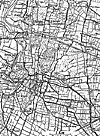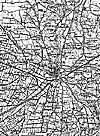1. Introduction
1.1 Chronology of events
 "Lonato? Well I've heard of that - Napoleon, first Italian campaign." might be the average answer to any question on Lonato.Little is still known about (all) the engagements of the 1796 campaign especially as regards units involved on both sides. Diving into the vast material of the Vienna Kriegsarchiv I found the relevant Austrian orders of battle and reports. Surprisingly the Austrian archive was as informative on the French as on the Austrians: old maps drawn by French officers after 1800 were 'acquired' by the Austrians during their 1814 occupation of Paris and were taken to Vienna. They offer complete French ordres de bataille and what might be more interesting an insight into the use of French republican divisions' in 1796.
"Lonato? Well I've heard of that - Napoleon, first Italian campaign." might be the average answer to any question on Lonato.Little is still known about (all) the engagements of the 1796 campaign especially as regards units involved on both sides. Diving into the vast material of the Vienna Kriegsarchiv I found the relevant Austrian orders of battle and reports. Surprisingly the Austrian archive was as informative on the French as on the Austrians: old maps drawn by French officers after 1800 were 'acquired' by the Austrians during their 1814 occupation of Paris and were taken to Vienna. They offer complete French ordres de bataille and what might be more interesting an insight into the use of French republican divisions' in 1796.
Large Map 1 (very slow: 173K)
Jumbo Map 1 (extremely slow: 381K)
The vicinity around the little Italian town of Lonato, situated to the South of Lake Garda, was the scene of two "battles" during Napoleon's famous 1796 campaign in Italy or more exactly during the Castiglione campaign in midsummer 1796. Feldmarshal Wurmser who had replaced FZM Beaulieu at the head of the K.K. Lombardische Armee on July 29th had successfully emerged from the Tirolean Alps to free Mantua which was besieged by the French Armée d'Italie under Napoleon. When on July 30 the Austrian right wing in the West under FML
Quosdanovich took Brescia in the French rear Napoleon decided to raise the siege of Mantua and concentrate all available forces against Quosdanovich to protect his lines of communication. On his way to Brescia 31 July he found a small Austrian force in his way, one of Quosdanovich's brigades, commanded by Major-General Ott. The ensuing battle was fought around Lonato and ended with Ott's retreat to Ponte di San Marco.
On 1st August Napoleon reached Brescia and found that the Austrians had already left the town and retreated to the mountains in the north. Considering his communications again secured, he sent his two smaller divisions (Despinoy and Sauret) in pursuit and on the 2nd August, with the bulk of his forces, he marched to the Chiese determined to attack those Austrians who had come by the Adige valley: thus division Augereau was to the South at Montechiaro and next day would encounter Wurmser's advance-guard under Liptay in the "combat of Castiglione"; Napoleon with division Massena was more to the North at Ponte San Marco. He would encounter another of Quosdanovich's brigades: that commanded by GM Ocskay in the (2nd) Battle of Lonato.
It ended with Austrian disaster: Ocskay's force was shut up in Desenzano and all the Austrians including their general were taken prisoner.
There is no place here to retell the actions of all the French and Austrian higher formations during the 31st July to 3rd August 1796: only short briefings will be given. These are supplemented by translated French and Austrian reports to give the sub-unit commander's view. Style (e.g. length of sentences), abbreviations and orthography were retained to transmit the late 18th century feeling. For those readers who want to backup their knowledge on the Castiglione campaign I suggest a reread of John Walsh's article on the Castiglione campaign in FE 23. The Westpoint Military Atlas of the Napoleonic Wars and Chandler's Campaigns of Napoleon would offer good surveys also.
 1.2 The site of the battles
1.2 The site of the battles
Lonato is a small Italian town situated on a hill rising distinctively above the surrounding ground. The dome of its church can be seen from far away. Its large Scaliger castle situated immediately north of the town's old centre offers excellent views in all directions.
Large Map 2 (very slow: 183K)
Jumbo Map 2 (extremely slow: 402K)
To the East of Lonato the last of the moraine hills surrounding Lake Garda's southern shore come quite close. (Lake Garda once was a glacier). Over these hills both battles of Lonato raged:
On July 31st the French started their attack from there; On August 3rd the Austrians were to be hurled back over them after they had been beaten on the western side of the town. To the South is the endless plain of the Po valley which stretches to the West as well, where the Chiese is heading to the South passing Ponte San Marco and Montechiaro. To the North of Lonato the moraine hills are merging with the last foothills of the Alps. Today the land is totally cultivated and the hills are covered with woods or brush. In 1796 this was not the case due to non-mechanised agriculture and the need to cut down any tree available for cooking or heating.
More Lonato:
Back to Table of Contents -- First Empire #36
Back to First Empire List of Issues
Back to MagWeb Master Magazine List
© Copyright 1997 by First Empire.
This article appears in MagWeb (Magazine Web) on the Internet World Wide Web. Other military history articles and gaming articles are available at http://www.magweb.com